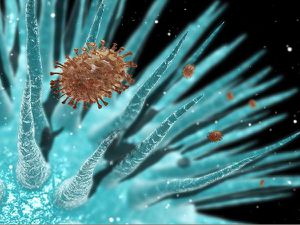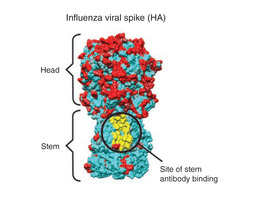Influenza Vaccine: Difference between revisions
| Line 1: | Line 1: | ||
==Introduction== | ==Introduction== | ||
The influenza vaccine is a highly controversial vaccine, and has several unique qualities that make it an especially interesting topic of research.<br><br> Vaccines work by exposing the body to the right antibodies to fight a particular disease. (more about how vaccines work)<br><br> | |||
But, the influenza virus is a rapidly evolving pathogen. The virus evolves enough from season to season that a new dose of the vaccine is necessary every year, as last year's antibodies usually can not recognize this year's strain. See antigenic drift section.<br><br> | |||
[[Image:Influenzafigure200.jpg|thumb|300px|right|Electron micrograph of the Inflenza virus. This shows the virus (brown) invading cilia (blue) in the airway of a human lung. http://science.nationalgeographic.com/science/photos/influenza/]] | [[Image:Influenzafigure200.jpg|thumb|300px|right|Electron micrograph of the Inflenza virus. This shows the virus (brown) invading cilia (blue) in the airway of a human lung. http://science.nationalgeographic.com/science/photos/influenza/]] | ||
<br><br>Other examples: | <br><br>Other examples: | ||
<br><b>Bold</b> | <br><b>Bold</b> | ||
Revision as of 22:02, 5 November 2013
Introduction
The influenza vaccine is a highly controversial vaccine, and has several unique qualities that make it an especially interesting topic of research.
Vaccines work by exposing the body to the right antibodies to fight a particular disease. (more about how vaccines work)
But, the influenza virus is a rapidly evolving pathogen. The virus evolves enough from season to season that a new dose of the vaccine is necessary every year, as last year's antibodies usually can not recognize this year's strain. See antigenic drift section.

Other examples:
Bold
Italic
Subscript: H2O
Superscript: Fe3+
Implications of the evolution of the influenza virus
Include some current research, with at least one image.

Section 2
Include some current research, with a second image.
Conclusion
Overall text length should be at least 1,000 words (before counting references), with at least 2 images. Include at least 5 references under Reference section.
References
Edited by [Author Name], student of Joan Slonczewski for BIOL 116 Information in Living Systems, 2013, Kenyon College.
